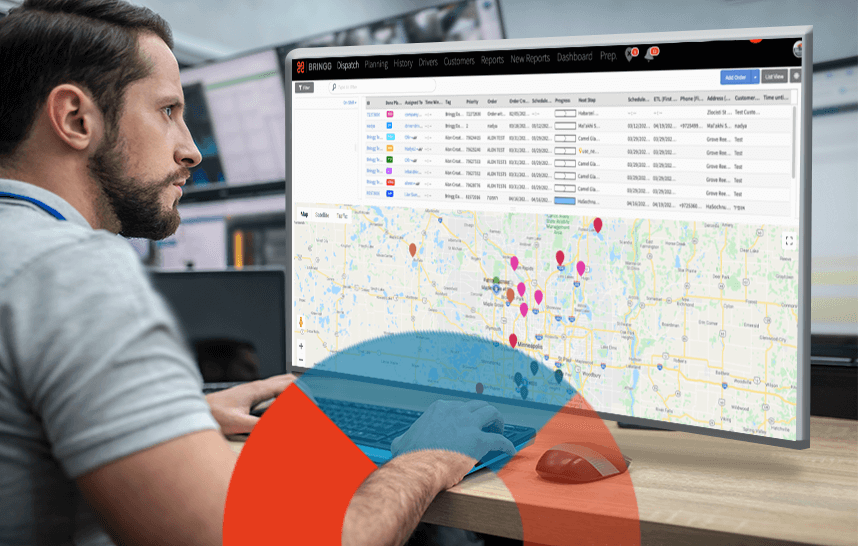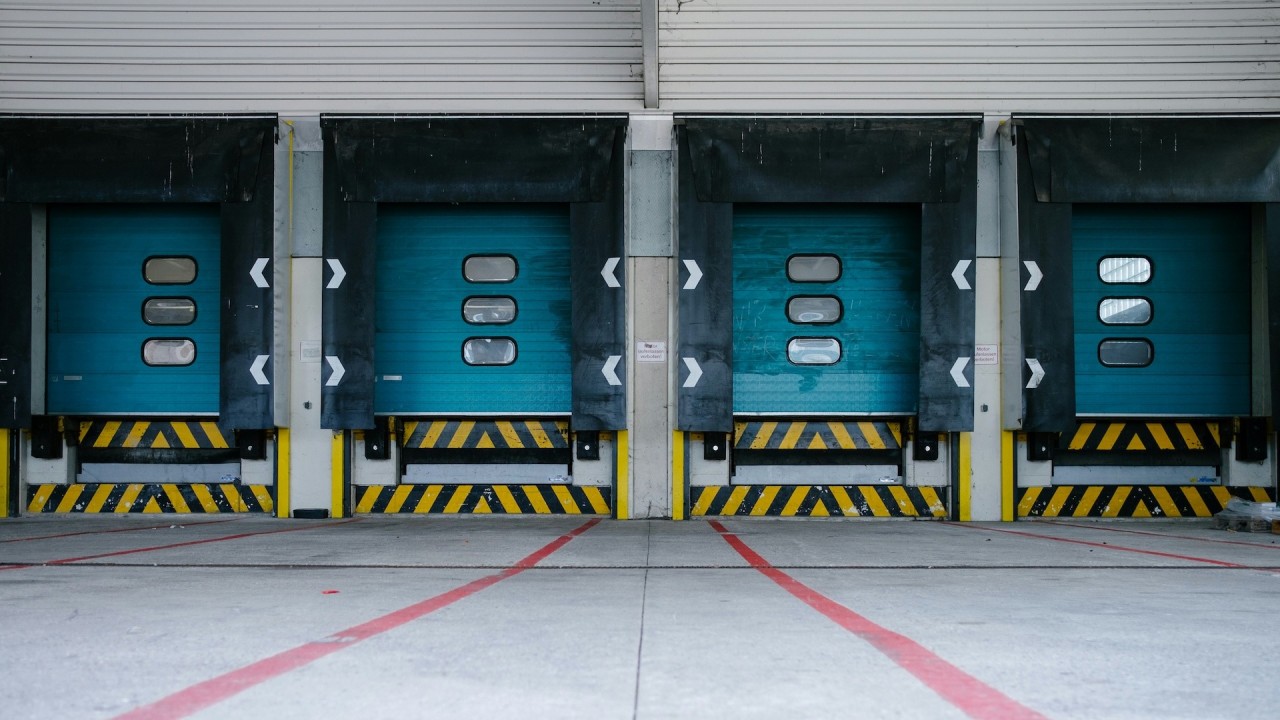We’ve officially reached new highs for delivery penetration. Retailers facing high customer demand are struggling to manage order fulfillment with carriers that are out of delivery capacity. Logistics and transportation providers, in turn, are seeing an influx of demand for B2C delivery, and next-day delivery, and are looking for solutions to better manage these new operations – in particular shipping costs and speed. This has upped the need for logistics companies to make sure that their supply chain management is as effective as possible, which means focusing on logistics software.
Some logistics and transportation companies turn directly to ready-made, of-the-shelf logistics solutions or customizable logistics management software to improve their services. Others look into building the relevant technology in house. But, which is the better approach?
The dilemma of building vs buying isn’t new and is applicable to most aspects of business operations. We understand the impact and implications of such an important strategic decision. After all, delivery software impacts many roles within the business – management, dispatching, drivers, partners, shippers and end customers. Like any other business decision, companies have to assess the pros and cons of both options.
This post explores the key issues that businesses must consider when choosing to build or buy logistics software of any kind.
NOTE: Logistics management software can refer to a wide range of technology solutions, including order management, freight forwarding software, trucking software, and tools to manage shipments in the early legs of the supply chain. This post focuses on logistics software used to manage shipments in middle and last mile shipping.
Why is logistics software essential?
In the past, third party logistics providers focused on multiple stages of the supply chain, including the first, middle and last mile. This included handling transportation management, inventory management, warehouse, operations, and fleet management. While these services still exist, logistics companies are moving increasingly towards last mile delivery services as a result of today’s market’s demands.
To manage growing delivery volumes and maintain customer satisfaction, logistics providers need a digitized system in order to orchestrate their operations.
In fact, many of the key features in these systems have already been widely adopted in the logistics industry. According to a recent survey of logistics providers, 58% are already using some form of automated dispatching and routing, and 42% plan to purchase. The same levels of adoption apply to order batching and other tactics for efficient logistics. The advantage of logistics software solutions is that as technology advances and changes, software changes as well to address company needs. As more logistics companies integrate last mile services into their sales and business strategies, the need for innovative solutions has become pressing.
What is logistics management software?
In order to understand the considerations involved in this type of solution, it’s important to first look at the definition of logistics and what is involved in logistics processes.
Logistics relates to the transfer of goods from the point of origin to an end location – often a consumer or business – and often with many additional stops in between. Logistics management is about coordinating the delivery of goods and managing the supply chain from the first mile to the last. This involves inventory management, fleet management, and coordinating inbound and outbound logistics processes across the supply chain.
This process requires high levels of coordination and communication between multiple players to ensure accurate and efficient transportation operations. Logistics management may also include customer relationship management that focuses on providing customers with the best possible service across every shipping method used.
What are the key features of logistics software?
When searching for a logistics management software system, it’s important to identify the features that are most important to your operational requirements. This will help you choose the right logistics software for your specific business needs.
Key features in logistics software:
- Warehouse management software
- Supply chain management software
- Transportation management software (including tools for dispatch and route management)
- Third-party fleet management software
- Route optimization software
- Logistics scheduling software
- driver and vehicle management (e.g. trucking software)
- document management
Reverse logistics approach the same flow and considerations, but backwards – with the end consumer being the point of origin, and the end location being a warehouse or fulfillment center.
Logistics management software is about replacing manual logistics processes to enable faster growth of delivery volume, greater delivery speed, and better risk management. In essence, it is about getting the right items to the right customers at the right time, while keeping up with increasing demand along the supply chain. Customer experience is also an important consideration, as both brands and end customers desire visibility into the shipping process.
While there are retailers who manage their logistics in-house, the vast majority expect their logistic service providers to utilize technologically advanced logistics software with real-time data transfer and advanced automation. This stresses the imperative for logistics providers to apply logistics management solutions that improve their delivery services.
Why consider in-house logistics management systems?
Most retailers considering using an in-house solution assume that they will be increasing savings by using resources that they already have on hand. If a company has an in-house IT team, they may push to build the logistics management software themselves. They believe in many cases that this will be the cheaper and faster option than purchasing and integrating an external solution.
IT teams also believe that creating in-house solutions will lead them to have greater control over their program as they can shape it to meet their exact specifications.
This decision may look like a good deal to decision makers in large companies that have available budgets to use for building and integrating an in-house system. Some companies do have success with this method; however, many come out spending significantly more than originally budgeted in the process (often because the project takes longer than planned).
Now that we’ve discussed the considerations for building logistics software in house, let’s look at why many businesses prefer the alternative: using readily-available, pre-existing logistics management software systems.
9 reasons to use logistics software as a service
- Time constraints – fastest time to value
- Technical expertise – benefit from best practices and expertise
- Easier Integrations across the supply chain
- Fleet and driver management capabilities
- Budget and maintenance costs are reduced
- Easier Onboarding and less disruption for teams
- Risk management and safety tools included in service
- Flexibility and future growth is accommodated for
- Benefit from cloud based software
1. Time Constraints
Logistics service providers are busy, more so today than ever. They do not have the time to create a bespoke software solution which can take months as well as include a significant investment.
Management software is the tool that allows third party logistics companies to become reliable in the eyes of their customers. If two years ago, profitable businesses could have afforded to take the time to build in-house logistics management systems, this is no longer the case. It is important to set realistic expectations about the time it will take to build and deploy at scale. (versus launching an MVP).
If you’re planning to build an in-house supply chain management system, this will come at the expense of delivering greater volumes and potentially risk market share
Logistics service providers don’t have the time to bury resources in developing complex software. They need immediate solutions to keep up with increasing demand. A pre-built solution has the added advantage of taking future iterations, software updates and maintenance off of your hands – issues which can be extremely time consuming and in many cases hold back company growth.
2. Technical expertise
86% of digital transformation projects in the supply chain fail.
While an in-house dev team may be capable of developing a logistics management system, it might not be their core competency. When purchasing a purpose-made solution from a tech vendor that specializes in the field, you’re buying technology that has been tried and tested by a team that understands the challenges from multiple points of views and client use cases.
This is critical, since 86% of digital transformation projects in the supply chain fail. Your logistics operations are too strategically important to be allowed to fail. It’s important to highlight this in order to understand that purchasing technology goes way beyond buying software – it’s also about tapping into the know-how of experts that will be able to assess, advise and even preempt future issues or challenges with significant foresight.
Software selection, integration, implementation and optimization is complex. The advantage of purchasing software as a service is that it usually comes with guidance in the form of implementation managers or a project management team whose sole role is ensuring the optimal implementation of their logistics system.
3. Integrations across the supply chain
In house development means often that the integrations will be hard coded. If a third party system – is changed for whatever reason, it is not simple to change out one for another.
One side of integration is with existing platforms within one’s own organisation; another is integrations with systems in your partner organisations.
3PL logistics companies, for example, need to integrate with their shipper’s systems; if you are a retailer, you’ll be using third party fleets and may need to integrate in order to provide customers with scheduling options. Restaurants need to integrate their menu across all eCommerce marketplaces to ensure consistency.
These integrations – including POS, OMS, TMS, and WMS systems – are critical for collecting and transferring data from across the supply chain that affects the success of your delivery operations. This can include data on inventory, order location, driver and vehicle data; fleet availability, order details, and more.
Seamlessly integrating multiple systems, and ensuring that data is transferred, in real time, is not an easy process. Out of the box logistics management software which can integrate with your existing systems – as well as those of your customer or partner – will significantly speed up your logistic software’s time to launch. The best logistics software will also include a real time sync between teams and systems, allowing for greater optimization of delivery speed and efficiency.
4. Fleet and driver management
Will your logistics management software provide solutions for both owned and third party carrier management?
Logistics service providers often work with multiple contractors, each of whom may independently handle planning and routing for their drivers. This means that any supply chain management software must be accessible to contractors outside of your company.
For retailers, logistics operators or providers are the medium through which customers experience the retail brand. To ensure good delivery experiences and customer loyalty, retailers must have a measure of control over their last mile carrier or carriers. Even if you aren’t using third party logistics at the moment, chances are that you will expand your services to additional retail locations or regions.
Enterprise resource planning software takes third party logistics into consideration. The more robust software will include different user roles that allow third party providers to dispatch drivers, plan routes, and view delivery performance – but only for their teams. The main user is able to view data from all third party providers. This dual resolution of visibility and control is difficult to achieve without taking the needs of your partners into consideration.
Logistics software built keeping these parameters in mind will provide the tools that both you and your third party fleets need to expand operations without negatively impacting speed, visibility or the customer relationship.
Read: Third Party Delivery Done Right: Why We Built a Delivery Network
5. Budget and maintenance costs
Building a robust logistics software system that can withstand surges in volume is neither easy nor inexpensive. Furthermore, maintaining logistics management software internally takes ongoing resources which often are not accounted for in supply chain budgets.
While having full ownership over the scope and scale of a platform will suit some companies, it is important that they take into account the ongoing maintenance costs and resources needed throughout the entire lifecycle of the product. Most ready-to-use logistics software includes regular upgrades, new features, and maintenance as part of the subscription cost, along with volume tiers that allow businesses to rapidly expand their usage without rewriting the software. Given the time and money this can save your businesses, it is often the preferred option for companies who view their logistics management software as a strategic, long-term solution.
6. Onboarding, transitioning, and disruption
Will onboarding teams to new logistics software impact driver efficiency?
Companies must consider carefully what the onboarding or rollout for their technology looks like. Implementing swiftly and with minimal disruption is key; however onboarding staff and getting buy-in from all internal stakeholders and employees is also critical.
Transitioning your operations to a new logistics software system, and onboarding users, can cause disruptions to individual tasks and your operations as a whole. If done badly, it can even contribute to churn rates. This is enhanced within the logistics space because of the direct impact the changes have on the day jobs of many employees and ultimately the customers and recipients.
The best logistics software solutions are generally developed with ease of use – as much as efficiency – in mind. If employees have access to onboarding materials and applications which are easy to use, it will ensure a fast onboarding process and a positive impact on efficiency and business processes in general.
7. Risk management and safety
A supply chain is notoriously averse to risk. According to Gartner’s Hype cycle for supply chain management technology, 48% of respondents would only work with technology that has passed the earlier phases of the hype cycle. Given this, it’s no surprise that companies carefully weigh options before making decisions on software for their logistics business.
When you pay for logistics tech, part of the price tag includes tools that minimize legal risk, protect drivers, and ensure that your logistics operations meet the required regulations. For example, solutions may include driver flows with mandatory safety training which must be completed before drivers can move on to delivering. Drivers can manage contactless delivery through photographic proof of delivery.
Some logistics software providers even include telematics integrations which can track driver behavior and prevent accidents before they happen. These are not just add-ons, but elements that are critical to the efficiency and bottom line of your logistics operations.
Another type of risk which purchasing software removes is a reliance on internal stakeholders. Many businesses unwittingly leave operational planning and execution in the hands of one or two skilled employees. This creates a dangerous knowledge silo that can disrupt operations if the employee leaves. By turning to a SaaS logistics solution, businesses remove this danger entirely and let the software provider function as an evergreen knowledge base for their operational use cases.
8. Flexibility and future growth
Don’t lose time on building a solution that may not scale.
If we’re learned anything throughout COVID-19, it’s that the ability to scale quickly is essential. Companies that were ready to adopt technology including logistics management software were at a stark advantage over those who lagged in making decisions regarding their management software.
If you build software for your current services, trying to expand it to fit different shipping services later may be like putting a patch on a leak instead of fixing it. You need solutions which fit your needs now, but will give you room to expand later on.
Many vendor-based solutions are flexible and allow for customization or modifications to their functionality. A rare few will offer tools which can be launched immediately, but which can also be customized, merging the advantages of in-house and purchased logistics solutions.
9. Cloud based software
Cloud-based software provides a host of benefits, from better data security, to automated updates and versions, and easier collaboration and data sharing with external partners. A key feature of data on the cloud is that it is usually available from any location and any device.
Most importantly, cloud platforms make it easy to scale your solutions up and down – add new API integrations, or increase users and delivery volumes, for example – without demanding anything of your internal resources.
How to benefit from logistics management software: flexibility, customization, scale
We’ve outlined the top features and considerations when considering the right logistics management strategy for your company. These should center on choosing advanced open technology that allows you to customize the software to meet their specific use cases, provide the flexibility to manage multiple sales channels, and easily scale your ecommerce fulfillment and delivery services. Most of all, any technology you choose should provide solutions that will meet the needs of your company as your logistical operations grow, including new service models, partners, regions, and revenue channels.
Frequently asked questions:
Logistics management software is software that shippers or logistics companies use to coordinate all stages of order management and delivery. This includes all steps of the process from the first mile until the last mile. Different logistics management software programs provide different features, depending on the type of program and the needs of the company.
Logistics management software is a critical component to scaling delivery operations for both shippers and logistics providers. Logistics management software gives companies the opportunity to optimize their process, save money, create happy customers, minimize risk, and more.
The best logistics software for each company is one that meets the specific demands and needs of that company. This means managing various parts of the logistics process such as inventory and supply chain, transportation and route optimization, driver and vehicles, documents, etc.
A wide range of software types may be used in logistics processes. Depending on a company’s needs, logistics software may include warehouse management software, supply chain management software, transportation management software, third-party fleet management software, route optimization software, logistics scheduling software, driver and vehicle management, and document management software.



